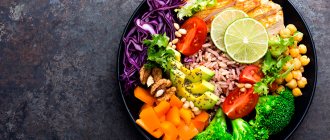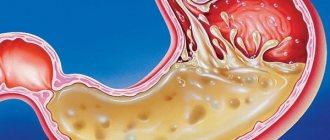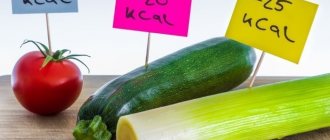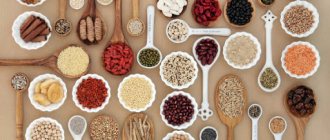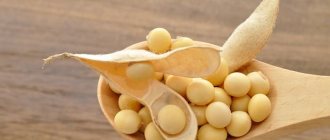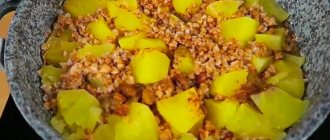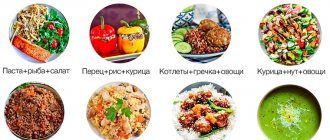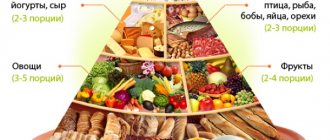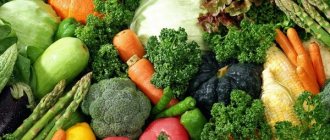Every person needs quality products. People who decide to lead a healthy lifestyle are interested in the question of how to eat tasty and healthy - they want to know everything about food. Every person who sooner or later comes across the principles of healthy eating needs to learn how to choose foods for proper nutrition and figure out which foods are healthy.
What does healthy food consist of?
A healthy diet should not include food that contains pesticides. Products with a balanced diet should contain 4 main components that allow you to get rid of excess weight and normalize the functioning of internal organs and the digestive tract. These include:
- BJU (proteins, fats, carbohydrates). They are considered the main sources of energy and building material for cells.
- Fiber. Coarse fiber that normalizes the digestion process.
- Mineral components. Due to them, water metabolism and electrostatic tension in internal organs are normalized; they participate in most enzymatic processes and in the construction of tissues.
- Vitamins. They strengthen the immune system and are responsible for a person’s appearance; they will also help normalize metabolic processes in the body.
Descriptions of food products, their names and detailed composition will help you decide on the choice of diets for weight loss.
Before you start eating healthy, you need to decide which foods are environmentally friendly and which are not.
With a list to the store
If your personal list is ready, let's go shopping!
Before doing this, I advise you to have a snack - with an empty belly, you can rush and put what you don’t need in the basket.
also better to take a specific route, trying not to go near departments with sweets , cakes, ice cream and cookies.
It is also better not to visit departments with prepared food, especially at the beginning of your journey, while you are still learning to plan your diet.
Let's read the composition! This is very important - often a product that is healthy and correct at first glance may contain various taboo additives.
Ecological purity is the basis
The basic products from which food is prepared for a balanced diet must be satisfying, nutritious, of good quality and environmentally friendly. Before choosing components, you need to know their origin, type of processing and at least an approximate chemical composition. Healthy products must be organic, that is, they must be grown without the use of chemicals - pesticides, thanks to which plants are protected from the harmful effects of the environment, insects and other pests.
Environmentally friendly products can be found in specialized retail outlets, which have been regularly opening throughout the Russian Federation since 2015. You can purchase them at markets, from farmers who grow crops on small plots, or try to run your own farm - produce eco-products yourself. To simplify the choice, experts recommend purchasing a special device that allows you to determine the residual level of nitrates with almost 100% accuracy. The name of the device is nitrate tester.
If the concentration of nitrates in fresh vegetables and fruits is high, then the residual amount of pesticides can be reduced independently: to do this, pour warm water into a large saucepan and add 15 ml of apple cider vinegar and 15 g of crystalline sodium carbonate. Vegetables and fruits are soaked in the resulting solution for 30 minutes, then washed in plenty of water and dried.
Sample menu and daily routine
You can create the following diet by swapping the following dishes:
| Meal time | Option 1 | Option 2 | Option 3 | |
| Breakfast | 6:00-9:00 | Boiled rice, butter, coffee, apple | Oatmeal, tea, banana | Potatoes (unfried), cucumber, milk |
| Lunch | 10:00 | Boiled egg, tomato, whole grain bread | Green tea, apple | Grapefruit |
| Dinner | 12:00-14:00 | Cauliflower, baked mackerel | Borscht with meat, black bread | Baked chicken |
| Afternoon snack | 16:00-17:00 | Cottage cheese | Grape | Cucumber salad |
| Dinner | 18:00-20:00 | Chicken with mushrooms | Seafood with cucumber | Steamed fish cutlets |
Naturally, this is an approximate diet; in fact, there are many options for creating a menu.
In general, a person’s diet should contain no more than 300 g of berries and fruits per day. Whole grain cereals and beans - about 75-90 g. Vegetables - about 300 g. It is recommended to eat fish or meat daily, alternating dishes. You are allowed to consume 2 tablespoons of seeds or nuts per day. It is better to choose low-fat dairy products, yoghurts, and kefir.
Particular attention should be paid to the amount of sugar and salt. Sugar should not be more than 5 teaspoons, and salt should not be more than 1 spoon. You can consume no more than 70 g of fat per day.
Be sure to read what is written on the label, avoid products with hydrogenated fat, these are trans fats that will negatively affect your health.
List of foods recommended for proper nutrition
Many people are interested in the question of what foods can be consumed with a balanced diet. Let's consider a list of foods that are beneficial for the body, containing fast carbohydrates, large amounts of vitamins, fiber and rich in animal protein. These include:
- cereals – corn, barley, oatmeal, rice, buckwheat;
- legumes - beans, peas, chickpeas, soybeans, lentils;
- cereals – rye, wheat;
- raw vegetables - carrots, bell peppers (sweet), tomatoes, cucumbers, onions, rhubarb;
- processed vegetables (cooked) - cauliflower and white cabbage, potatoes, beets, eggplants, zucchini;
- fruits - apples, bananas, oranges, tangerines, grapefruits, plums, kiwis, peaches, apricots;
- berries – currants (red black), rowan, raspberries, strawberries, cranberries;
- nuts – almonds, peanuts, walnuts, hazelnuts;
- mushrooms – truffles, porcini, boletus, oyster mushrooms, honey mushrooms, chanterelles, champignons;
- vegetable oils – olive, sunflower, corn.
Products allowed during a balanced diet include pasta. Before purchasing, it is important to pay attention to what varieties of cereals they are made from.
Pasta made from durum varieties is considered the most useful - it is low in calories, does not overcook and does not overload the digestive tract.
Meat must be present in the diet. Some types of meat contain a large amount of fat (pork, fatty beef).
Dietary food should include salads, sauces, spices and seasonings. They do not need to be completely excluded from the diet, just reduce the amount. Dietary products should contain the optimal amount of protein.
Full list of products
Proper, balanced nutrition should bring pleasure, so experts recommend deciding on your gastronomic preferences in advance. List of products for a proper diet in alphabetical order:
- legumes (chickpeas, peas, beans);
- greens (dill, parsley, cilantro);
- cereals (buckwheat, rice, pearl barley, barley);
- meat (chicken, turkey, rabbit, lamb, veal);
- vegetables (spinach, broccoli, potatoes, carrots, leeks);
- seasonings (khmeli-suneli, cumin);
- offal (heart, kidneys, veal liver);
- spices and sauces (white and black pepper, bay leaf, sour cream sauce and lemon butter dressing);
- fruits (apricots, quinces, bananas, avocados, pineapples);
- berries (cherries, sweet cherries, raspberries, blueberries).
Exotic fruits must be consumed with caution - they can cause allergies.
Groups of products that will make your life better
The dietary menu must be compiled depending on the existing diseases of the internal organs. Experts recommend adhering to the conditional classification of products for a particular pathology. Allowed foods for stomach ulcers:
- vegetables (broccoli, spinach, celery, carrots, bell peppers, pumpkin);
- cereals (rolled oats, semolina, rice);
- meat (turkey, chicken, lean beef, lamb);
- fish (halibut, cod, pike perch);
- dairy products (cottage cheese, kefir, yogurt, yogurt).
Hypertensive patients need to eat fresh vegetables, lean fish, dairy products, fruits, dried fruits, seafood, cereals, and legumes. Avocados, dried apricots, white cabbage, broccoli, fresh herbs, sorrel, spinach, arugula, potatoes, carrots, cereals and legumes are good for hearts. Meat and fish - low-fat varieties, nuts - almonds, cashews, peanuts.
Overweight people need to focus on greens, fruits and vegetables.
Dairy products, fish, meat - only low-fat varieties, sausages - boiled types (sausages, sausages).
Table of permitted products for PP
Good foods contain fiber, fresh vegetables and fruits are enriched with vitamins and minerals. Table of useful products:
| Category | Product Name | Calorie content |
| Proteins (proteins) | Fermented milk | 87-149 |
| Meat and offal | 140-360 | |
| Fish | 100-340 | |
| Seafood | 98-214 | |
| Fats | Nuts | 620 |
| Vegetable oils | 900 | |
| Seeds and sunflower seeds | 570 | |
| Butter | 770 | |
| Carbohydrates | Legumes | 60 |
| Cereals | 330 | |
| Pasta | 280 | |
| Cereals | 311 | |
| Cellulose | Vegetables | 20-80 |
| Fruits | 40-90 | |
| Greenery | 19-30 | |
| Berries | 40-112 |
If your blood sugar level is high, experts recommend eating dried fruits – they eliminate the feeling of hunger and contain a small amount of fructose.
Products needed during pregnancy
Pregnancy is a very important and responsible period in the life of every woman. Especially, the nutrition of the expectant mother plays an important role. With it, the fetus receives all the necessary substances involved in the formation of organs and tissues of the body. If they are deficient, pathology may occur, leading to disability or even non-viability of the baby.
- The majority of a pregnant woman's diet should consist of fresh vegetables and fruits that are low in allergenicity. It is advisable to eat about a kilogram of them per day. The most useful are:
- red bell pepper - has a beneficial effect on the teeth, nails and hair of the fetus; - pumpkin - has a diuretic and laxative effect; — beets – rich in magnesium, promotes the excretion of radionucleotides, has a laxative effect on the intestines; - apples - protect the fetus from allergic reactions, reduce blood cholesterol levels, stimulate the immune system and improve intestinal function; — pomegranate – has a general strengthening effect, prevents the formation of atherosclerotic plaques, and remarkably quenches thirst; - pears - have a diuretic effect, reduce swelling; — melon – promotes the formation of the baby’s nervous system, thanks to the folic acid it contains.
- Dairy products should occupy a major place in the diet of the expectant mother. They are suppliers of protein and amino acids, vitamins, calcium, necessary for the formation of the child’s bones. Cottage cheese is especially rich in nutrients.
- Meat should be a complement to main dishes. It is advisable to eat rabbit meat, dietary poultry, beef, pork, and veal.
- Seafood, fish and seaweed are rich in protein, microelements and polyunsaturated fatty acids.
- Walnuts and pine nuts are highly recommended because they improve digestion and elimination of toxins due to dietary fiber. They also contain protein, microelements, vitamins, and fatty acids.
- During pregnancy, you can drink weak tea. It is rich in microelements (potassium, calcium, fluorine, phosphorus) and theophylline, which reduces the tone of blood vessels.
- You need to eat sea or iodized salt to taste (the main thing is not to over-salt). It supports immunity, participates in metabolism and the exchange of amniotic fluid.
- Olive oil is considered very useful. It promotes the formation of the fetal nervous system, protects against gestosis, is excellent for constipation, stretch marks and postpartum depression, and strengthens the immune system.
A set of products for weight loss. The main rules for losing weight
The basics of proper nutrition for overweight people include eating healthy and nutritious foods that do not overload the digestive tract. Essential foods that speed up the fat burning process must contain proteins, carbohydrates and fiber. Fats of animal origin are replaced with vegetable fats, but they cannot be completely excluded from the diet.
Cereals and legumes
Legumes and cereals must be present in the diet menu. Dishes prepared using them quickly eliminate the feeling of hunger. Legumes and cereals contain complex carbohydrates, the breakdown of which the body spends energy on, thereby accelerating the process of releasing fat capsules from the subcutaneous layer. To retain all the nutritional value, crops must be cooked properly.
Fats
Fats of animal origin are contained in meat; the body cannot be completely deprived of them. Experts recommend reviewing the menu and excluding fatty meats (lamb, pork, beef). They are replaced to a greater extent by vegetable fats. Dishes with added meat should be present in the diet - they are prepared from turkey and chicken.
Fruits, vegetables, greens
The main emphasis when losing weight is on fresh products of plant origin. They contain vitamins, macro- and microelements, you can quickly get enough of them without compromising your health. The best vegetables, plant foods (list of products):
- potato;
- carrot;
- beet;
- celery;
- spinach;
- broccoli and other types of cabbage;
- sweet bell pepper;
- zucchini;
- eggplant;
- onion;
- rhubarb.
Fruits:
- avocado;
- apricots;
- pineapples;
- oranges;
- lemons;
- tangerines;
- kiwi;
- apples;
- pears.
Berries:
- watermelons;
- strawberry;
- raspberries;
- cherry plum;
- currant;
- plums
Dill, parsley, green onions and cilantro contain the optimal amount of minerals and improve the taste of dishes. They are most often consumed fresh.
Fermented milk
The main sources of protein are fermented milk and dairy products. The diet menu should include yoghurt, cheeses (feta cheese), kefir, yogurt and milk.
When purchasing, you need to pay attention to the fat content of the products - the percentage of fat content should not exceed 2.5%.
Meat, fish, seafood
Meat, fish and seafood can be eaten 1-2 times a day. Low-fat varieties of fish and meat go well with a side dish of stewed vegetables and boiled cereals. It is important to follow the basic rules for preparing dietary food - products are boiled, stewed in their own juices or steamed. Frying and deep-frying should be ignored. Vegetables and meat can be sauteed with the addition of a small amount of oil.
Garlic
There are few foods in the world healthier than garlic. Nutritionists regularly include it in the list of vegetables necessary for health. Garlic affects the body in the following ways:
- reduces blood cholesterol levels;
- normalizes hemostasis processes, prevents the “gluing” of platelets, minimizes the risk of stroke;
- improves the condition of blood vessels, prevents hypertension;
- stimulates metabolism;
- slows down the aging process;
- destroys helminths;
- activates the activity of the reproductive system, enhances sexual desire;
- has antiviral, antibacterial, antifungal activity.
Garlic effectively destroys pathogenic microorganisms thanks to the natural antibiotics in its composition. One of them, allicin, fights the bacterium metacillin-resistant Staphylococcus aureus. This is a dangerous pathogen that is resistant to synthetic antimicrobial agents. Additionally, allicin removes free radicals, preventing pathological cell division.
Note! Allicin is formed some time after garlic is crushed. To get the maximum benefit from the superfood, you need to cut it up and leave it for 10-15 minutes. During this time, allicin will have time to be released, and garlic can be used in cooking.
The vegetable strengthens the immune system, increases the body's defenses, helping it fight diseases. Garlic is not only the healthiest food in the world, but also a natural medicine. It is recommended for colds, digestive disorders, and biliary tract diseases.
Garlic contains the most essential vitamins for health – C and B. Ascorbic acid is a well-known remedy for strengthening the immune system. Vitamin C protects the body from colds, fights their manifestations, and increases defenses. Group B compounds normalize the functioning of the nervous system, help preserve youth, and improve the condition of the skin, hair, and nails.
Dishes with the addition of garlic are not only healthy, but also tasty. It is better to use fresh vegetables - powdered ones contain chemical additives. Garlic is used in small quantities, otherwise it may cause heartburn.
Proper nutrition. Fats, proteins, carbohydrates and fiber
All products are conventionally divided into 4 categories according to the content of certain components. They play an important role in human life, so experts recommend maintaining the ratio of fats, proteins, carbohydrates and fiber in food. A healthy diet requires a simultaneous intake of vitamins and minerals along with food.
Proteins are the main source of protein necessary for the normal formation of muscle tissue; fats are involved in the functioning of most systems (digestive, cardiac). Carbohydrates are a source of energy that is divided into 2 categories. Food enriched with fiber helps to lose excess weight and prevents the development of a number of chronic diseases.
Squirrels
Proteins, or proteins, contain the necessary concentration of amino acids involved in digestion. There are 2 types of protein - animal and plant origin, they must enter the body in equal quantities. Plant protein is found in beans, soy, lentils, wheat, chocolate and seaweed, while animal protein is found in meat, eggs and dairy products.
Fats
When losing weight, nutritionists advise focusing on foods containing easily digestible fats. These include certain types of fish (salmon, sardines, tuna), fruits (avocados) and nuts (almonds, walnuts, cashews). The consumption of animal fats should be partially reduced. Regular consumption of products in this category will preserve the elasticity of blood vessels and provide an influx of energy.
Carbohydrates
There are 2 types of carbohydrates - complex and easily soluble. The latter do not bring any benefit and are most often found in fast food and fast food; such food is transformed into fat deposits. Complex carbohydrates are found in cereals, mushrooms, pasta and dairy products. The consumption of products in this category should be regular.
Cellulose
Foods enriched with fiber help maintain normal weight. Unbreakable carbohydrate is found in nuts, grains, vegetables and fruits.
Fiber helps cleanse the body - by absorbing excess moisture and sugar, it speeds up the digestion process, stopping the development of fermentation and putrefaction processes in the intestines.
Turmeric
The spice, which gives dishes a beautiful golden color, is one of the healthiest foods in the world. It contains curcumin, a substance with powerful anti-inflammatory effects. Turmeric has been compared to pharmaceutical drugs, but without the serious side effects.
Another property of turmeric is that it slows down the aging process. The spice contains antioxidants that protect the body from free radicals and oxidative processes, and increase the activity of its own antioxidant substances.
The spice has a beneficial effect on the brain. A special hormone helps improve organ functions, protect against aging, and reduce cognitive functions. Turmeric improves its production, and the substance fights degenerative processes.
Turmeric reduces the risk of heart disease. The substances included in its composition promote endothelial regeneration. This tissue lines the inside of blood vessels, contributes to their elasticity and strength. Destruction of the endothelium provokes the development of cardiovascular disorders, problems with blood pressure, and impaired hematopoietic functions.
Research shows that turmeric functions as a drug that lowers “bad” cholesterol. It has anti-cancer properties, helps with arthritis, Alzheimer's disease, depression, and central nervous system disorders. It is useful to add turmeric to various dishes, make fortifying drinks, teas and decoctions.
Important! The spice is usually sold in the form of an orange-yellow powder. It quickly loses its aroma and beneficial properties, so it is better to use fresh plant root. It is finely chopped, grated or crushed in a blender, and then added to dishes. The powder is stored in glass, tightly closed containers.
General principles of healthy eating
People who try to adhere to the principles of proper nutrition are interested in questions about what foods can be consumed daily, how to properly prepare and combine them. Meals should be separate and fractional - the weight of portions in this case is 250-300 g. Particular attention should be paid to the methods of preparation - salads from boiled vegetables are not seasoned with mayonnaise, but with olive oil and lemon juice.
Seasonings and spices can be added to dishes, but in small quantities. Second fish courses are steamed, vegetables can be stewed and boiled. Wheat bread is replaced with rye bread, and the consumption of confectionery products is reduced to a minimum. It is important to completely give up bad habits; drinking alcohol is unacceptable.
Separate means useful
Proteins, fats and carbohydrates must be consumed correctly; some foods do not combine with each other. When preparing healthy meals, you need to be guided by the basic principles of separate nutrition:
- starchy foods are not combined with acids - bread is not eaten with tomatoes, tangerines - with bananas;
- carbohydrates are consumed separately from proteins - mushrooms are not eaten at the same time as porridge;
- acids and proteins are consumed separately - nuts and mushrooms are not eaten with oranges;
- complex and easily digestible carbohydrates cannot be combined with each other.
Eat only one type of food high in protein at a time - bread and pasta are incompatible.
Self-discipline
Many people are interested in the answer to the question of what can be cooked while adhering to a healthy diet, and what cannot be cooked. One of the main rules of healthy eating is self-discipline. If a person decides to lead a correct lifestyle, then he must adhere to it constantly. You should not break down and abuse alcohol; prohibited dishes and foods should not be included in your diet, even with a strong desire. Experts do not recommend abruptly switching to a balanced diet; they begin to eat healthy foods gradually.
Observation and analysis
According to reviews, by adhering to proper balanced nutrition, you can get rid of up to 7-8 kg per month. At the end of each week, experts recommend arranging fasting days - they will help cleanse the body of accumulated toxins and waste. If a person pursues the goal of losing weight, then fasting is strictly prohibited. With a balanced diet, you can not only get rid of extra centimeters, but also improve the functioning of most internal organs, especially the gastrointestinal tract.
We drink a lot and correctly
Maintaining a drinking regime is considered a prerequisite for proper nutrition.
You need to drink when thirst occurs, the minimum volume of liquid consumed is no more than 2 liters, but this does not mean that all drinks can be used. Permitted include:
- compotes from dried fruits and fresh fruits without added sugar;
- herbal infusions and teas, including green;
- fruit drinks;
- jelly;
- mineral water without gas;
- fresh juices;
- kefir;
- weak coffee and black tea;
- homemade lemonade;
- drinking yogurt.
Sparkling mineral water, carbonated sweet and alcoholic drinks must be completely excluded from the menu.
Fruit juices can be mixed with vegetable juices - such fresh juices are beneficial for the body.
Table of food combinations for proper nutrition
Nutritionists recommend observing food compatibility - this will avoid digestive problems. Food compatibility table (according to Sheldon):
| Products | 1 | 2 | 3 | 4 | 5 | 6 | 7 | 8 | 9 | 10 | 11 | 12 | 13 | 14 | 15 | 16 | 17 |
| 1. Fish and meat | 0 | + | – | – | – | – | – | – | – | – | – | – | – | – | – | – | – |
| 2. Green vegetables | + | 0 | + | + | + | + | + | + | + | + | – | + | + | + | + | + | + |
| 3. Vegetables with starch | * | + | 0 | + | + | – | + | * | + | + | + | * | + | + | * | + | * |
| 4. Butter | – | + | + | 0 | – | – | + | – | * | – | * | * | – | * | – | – | + |
| 5. Vegetable oil | – | + | + | – | 0 | – | + | * | + | + | * | – | – | – | – | – | + |
| 6. Sugar | – | + | – | – | – | 0 | – | – | – | – | – | – | – | – | – | – | – |
| 7. Cereals and flour products | – | + | + | + | + | – | 0 | – | * | – | + | – | – | – | – | * | – |
| 8. Dried fruits, fruits | – | + | * | – | * | – | – | 0 | – | – | * | * | + | – | – | * | * |
| 9. Legumes | – | + | + | * | + | – | * | – | 0 | * | + | – | – | – | – | + | – |
| 10. Potatoes | – | + | + | – | + | – | – | – | * | 0 | + | – | – | * | – | – | + |
| 11. Sour cream | – | + | + | * | * | – | + | * | + | + | 0 | – | – | – | – | + | + |
| 12. Milk | – | – | * | * | – | – | – | * | – | – | – | 0 | – | – | – | – | – |
| 13. Cottage cheese | – | + | + | – | – | – | – | – | – | – | – | – | 0 | + | – | + | + |
| 14. Cheese | – | + | * | – | – | – | * | – | – | * | – | – | + | 0 | – | – | + |
| 15. Eggs | – | + | * | – | – | – | – | – | – | – | – | – | – | – | 0 | – | – |
| 16. Nuts | – | + | + | – | – | – | * | * | + | * | + | – | + | – | – | 0 | + |
| 17. Mushrooms | – | + | * | + | + | – | – | * | – | – | + | – | * | + | – | + | 0 |
Table symbols: (-) – negative compatibility, (+) – positive compatibility, (*) – relative compatibility. Thanks to the data in this table, you can quickly navigate and prepare a dish in which the components are combined with each other.
Cabbage
The cabbage we are used to is included in the list of the healthiest foods in the world. It contains a set of nutrients necessary for human health. These are vitamins A, C, B, K, compound U, trace elements calcium, potassium, magnesium. The composition of the product includes L-glutamine, a nutrient substance necessary for the normal functioning of the brain and heart, strengthening muscles, and restoring the gastrointestinal mucosa.
Cabbage is a record holder for vitamin C content. It improves immunity, protects against colds, and normalizes the function of the nervous system. Vitamin A promotes skin rejuvenation, maintains visual acuity, and slows down aging. Nicotinic acid, or vitamin PP, which is found in cabbage, is responsible for processing fats and carbohydrates into energy, improves metabolism, and activates tissue regeneration.
Cabbage juice is useful to drink for ulcerative lesions of the digestive tract, inflammatory diseases, and intestinal irritation. The vegetable eliminates acid belching, heartburn, and bloating. It improves peristalsis, promotes the removal of processed food, rotting products, and toxins. The anti-inflammatory properties of the product are widely used for external use. The juice is used to treat acne, acne, skin inflammation, and burns. The elements in cabbage improve regenerative function, so that damage heals quickly.
The product contains dietary fiber, fiber, and natural bitterness. Thanks to this, it is included in various diets, and its calorie content is 27 kcal per 100 g. Cabbage leaves you feeling full and does not affect blood glucose levels. After eating a vegetable, there is no desire to eat something fatty or sweet.
Cabbage is beneficial regardless of the cooking method. Boiled is recommended for people with a tendency to excessive gas formation. It does not irritate the intestines and does not cause bloating or discomfort. Sauerkraut contains special enzymes that improve digestion, and vitamins and microelements are preserved.
Approximate list of products for PP for a week
You need to buy food from trusted retail outlets - this will minimize the risk of purchasing low-quality or spoiled vegetables, fruits and dairy products.
Nutritionists say that the healthiest foods are natural, naturally grown.
Grocery list for the week:
- Meat and offal (beef liver, chicken fillet, chicken breasts and thighs) - from 130 rubles per 1 kg.
- Cereals (buckwheat, rice, semolina) – from 50 rubles. per pack.
- Greens, vegetables and fruits (depending on gastronomic preferences) – 70 rubles. for 1 kg.
- Chicken eggs – from 50 rub. for 10 pcs.
- Dairy products (drinking yogurt, kefir, milk) – from 40 rubles. for 1 piece
- Bread and flour products (buns, rye or grain) – from 40 rubles. for 1 piece
The daily menu can be varied with fish - from 150 rubles, the total budget for PP products is at least 380 rubles. There is no need to purchase exotic fruits (papaya, passion fruit) - they can provoke allergic reactions in people who are not accustomed to them. Apples, pears and citrus fruits contain almost the same amount of vitamins.
How and where to start
It is clear that not a single list of the best products for proper nutrition and healthy weight loss can be called universal - each organism is special, and we all have individual preferences . Therefore, I recommend proceeding according to this scheme:
- studying theory;
- We make our own list of what to buy;
- We conduct an audit of household supplies, mercilessly throwing away everything prohibited (you can donate to charitable organizations if you don’t dare throw away the food);
- we save our grocery list (you can even print it out and hang it on the refrigerator);
- Let's go to the store and start shopping for the week.
It’s easy to create a personal list: write down from our article those products that you love, as well as those that are available in your region; cross out what you absolutely do not like or is not suitable for your health (allergies, intolerance); check to see if anything prohibited has been included.
After that, feel free to go shopping - now there will definitely be no harmful things or temptations in your refrigerator and on the shelves.
Prohibited foods for PP
Most people trying to maintain a balanced, fractional diet are interested in the question of which foods should be excluded from the diet. In view of this, when eating on a diet, it is recommended to count foods; fatty, hard, salty, smoked and spicy foods should be removed from the menu. It slows down the speed of metabolic processes, disrupting their synthesis.
Prohibited foods include smoked meats and sausages, fatty meats, fish and some seafood (oysters, mussels and octopus). You need to completely give up snacks, chips, crackers made from wheat bread and fast food. Dishes sold in fast food chains (french fries, nuggets) are deep-fried, so the food contains a large amount of carcinogens.
Instant noodles and quick soups should be completely excluded from the diet. They contain artificial flavors, flavor enhancers, and preservatives. They quickly, but not for long, satisfy hunger due to the high concentration of light carbohydrates. It is not recommended to consume tobacco products, baked goods, and chocolates - they contribute to the formation of cholesterol plaques on the vascular walls. Alcohol, energy drinks and those containing caffeine are strictly prohibited.
List of foods to avoid
Products prohibited for consumption include finished products that can be purchased in stores. Full list of products for the duration of the diet or during PN:
- Store-bought juices and nectars. They contain no more than 20-35% natural freshly squeezed juice, the rest is dyes, flavor enhancers, flavors and other food additives.
- Canned food. Such fish, vegetables and meat contain all kinds of E-additives, which have a detrimental effect on the functioning of the digestive tract and the entire body.
- Mayonnaise. The sauce is high in calories and also contains flavor enhancers. If desired, the sauce can be replaced with low-fat cream or sour cream.
- Ready-made seasonings for first and second courses. They can be replaced with fresh herbs, salt and ground black pepper.
- Sausages (smoked). The products are high in calories, they most often contain carcinogens and various food additives that allow sausages to be stored for a long time.
- Sweets. They are replaced with dried fruits, which contain the optimal amount of complex carbohydrates necessary for normal digestion.
Prohibited products include flour products cooked in vegetable oil. If desired, the pies are cooked in the oven.
Beet
The most useful thing about beets is not only the roots, but also the tops. It contains a record amount of potassium - more than bananas or carrots. The vegetable contains nitric oxide, which has a healing effect on the body. It strengthens the walls of arteries, normalizes blood pressure and hormonal levels.
Beets contain a complex of nutrients, vitamins, and microelements. These include manganese, boron, and iron. These microelements normalize hematopoietic processes, regulate metabolism, and strengthen the immune system.
The vegetable contains betaine, a substance that improves liver function. Beets are used for disorders of the intestinal microflora, constipation, and digestive disorders. The pectin in its composition suppresses the activity of putrefactive bacteria, soothes the inflamed mucous membrane, gently envelops it, and promotes the removal of feces. The root vegetable is useful for preserving cognitive functions, improving brain function, and preventing Alzheimer's disease in old age.
Beets are useful to eat during a diet. The calorie content of the root vegetable is only 50 kcal per 100 g. It promotes rapid weight loss not due to fluid loss, but due to improved metabolic processes. Additionally, the product improves sexual function, increases visual acuity, and normalizes thyroid function.
Beets are consumed raw or boiled. You can squeeze the juice out of the raw vegetable, take it as a general tonic, or use it externally. Beetroot juice is dripped into the nose for a runny nose. It contains antibacterial substances that destroy pathogenic microorganisms.
The use of onions in cosmetology
Juices and gruels prepared from fresh onions are widely used in cosmetology. They perfectly cleanse the skin and help get rid of freckles, rashes and age spots. The condition of the epidermis improves under the influence of beneficial elements, inflammatory processes go away, and many dermatological problems are solved. Onion stimulates and has a positive effect on hair structure and growth. Masks using it are considered the most effective against hair loss and brittleness, and are excellent at combating dandruff and flaking on the scalp. To combat lichen, it is enough to lubricate the damaged area with freshly squeezed juice.
A little history about growing onions...
Even in ancient times, people paid attention to the usefulness of cultivated plants. Onions did not stand aside in this regard. The first mentions of it are associated with the fourth millennium BC. There is no exact information about where this vegetable began to be grown, since its varieties are common in many areas of our planet. Some scientists consider its homeland to be Central Asia, others Afghanistan. Some historical data indicate that the Chinese began to grow vegetables. Judging by these sources, there was a mountain where a lot of wild onions grew, for which it received the name Onion Mountain or Dzunglin. Further, it began to be grown in India and Egypt, where it became a sacred crop. And the peoples of Ancient Rome and Germany believed that it helps to increase military strength, stamina, courage and vital activity.
